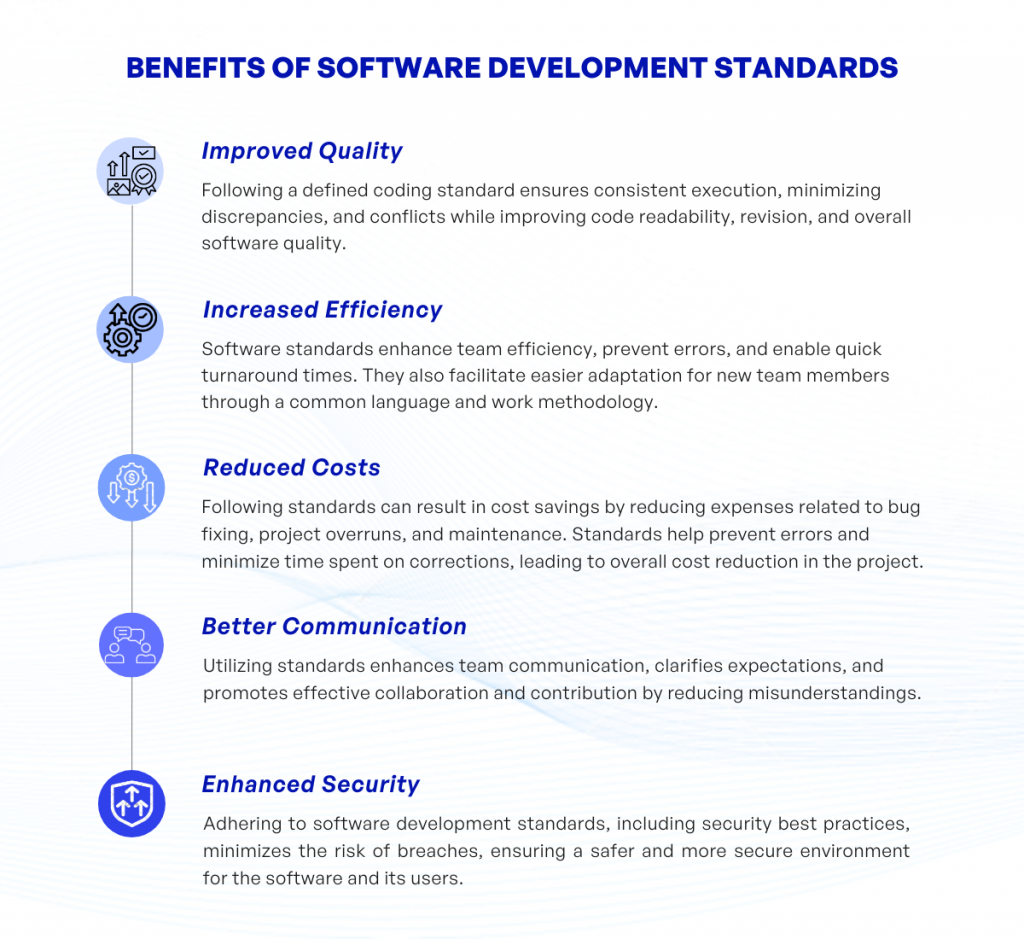
Ever wondered how professional software developers keep their code in check while continually crafting functional, robust, and efficient software? The secret lies not in any magic spell, but in adhering to standards and best practices for software development. As you navigate your way through this article, we’ll uncover these best practices and standards, paving your road to professional software craftsmanship.
1. Software Development Standards
Software development standards are a set of rules and norms that guide how the software development process should be conducted. It plays a paramount role in ensuring consistency, enhancing the quality of output, and facilitating efficient team collaboration. But what exactly does it involve? Let’s break it down.
The first aspect is coding standards, which establish guidelines for writing code. This includes how the code should be formatted, naming conventions, practices for comment, and how to structure the code for readability and maintainability.
Next are the architectural standards, which define the overall structure of the software system. It relates to how different parts of software interact with one another, as well as how data is stored and received. This ensures that the end result is a cohesive, efficacious, and robust system.
Naturally, testing standards cannot be overlooked. These standards ensure that all software is rigorously tested before release. It encompasses a plethora of testing methods ranging from unit testing (testing individual components) to integration testing (ensuring components work well together).
Another key component of the software development standards is the documentation standards. It refers to creating comprehensive, informative, and accurate documents that detail the design and functionality of the software system. This is crucial not just for future reference, but also for other team members to understand the breadth and nature of the software.
Finally, adhering to Project Management standards helps streamline the process of software development. It includes practices like following a defined workflow, allocating resources efficiently, and maintaining a timeline for deliverables. This invariably reduces chaos and ensures that the project stays on track.
In essence, software development standards are the bedrock on which high-quality, reliable software systems are built. Hence, every development process, irrespective of the size and complexity of the software, must adhere to these standards.
2. Benefits of software development standards

Imagine a world without standards – chaotic, unpredictable, and often disastrous, right? Well, the software development world is no different. The implementation of software development standards brings about many benefits. Let’s explore some of these advantages.
Improved Quality: Following a defined standard ensures consistency in the execution of code. Consistency in turn guarantees a minimum level of quality throughout the project. If everyone on the team adheres to the same standards, there are fewer discrepancies and conflicts. This makes the code easier to read, revise, and manage, translating into better software quality.
Increased Efficiency: Software standards can prevent common pitfalls and errors, making the team more efficient. When standards are implemented, best practices are in play, which often results in a quick turnaround time. Additionally, standards make it easier for new members to adapt since they provide a common language and method of work.
Reduced Costs: That’s right, following standards can save you money! The cost of bug fixing, project overruns, and maintenance can go down dramatically. This is because the use of standards helps avoid errors and reduces time spent on corrections, leading to overall cost reduction in the project.
Better Communication: Utilizing standards helps clarify expectations and goals, leading to more effective team communication. It reduces misunderstandings, making it easier for everyone on the team to collaborate and contribute effectively.
Enhanced Security: One key aspect of software development standards is ensuring the implementation of security best practices. By adhering to these, developers minimize the risk of security breaches, creating a safer and more secure environment for the software and its users.
Remember, standards are essentially documented agreements containing technical guidelines and instructions. They are meant to be the ‘rule book’, ensuring everyone plays the game the right way. Ultimately, these standards lead to improved productivity, efficiency, and product quality.
3. Balancing software development standards
Let’s face it; you need to find the right balance when applying software development standards. Like anything else in life, too little or too much of something is rarely beneficial. When it comes to software development standards, jumping between extremes can lead to unnecessary complexity or disarray. But how do you find the sweet spot? Let’s delve into this.
Finding the proper balance begins with understanding your project’s unique needs. Every project is unique, and it’s essential to tailor your approach accordingly. For instance, a project with a small scope may require less stringent rules than a more extensive and complex project. As a developer, you need to be adaptable and flexible, ready to apply the right standards where necessary while keeping the
actual needs of your project in mind.
Remember: Balance is not a ‘one-size-fits-all’ thing. It’s a dynamic state that changes as your project evolves.
- Communication is key: Discussion with your team can help you understand how to apply the right standards to your project. Regular inter-team dialogues can bring to light the areas where adjustments may be required. Remember, everyone in your team brings their own perspective and understanding. So, engage, communicate, and listen to them. You will be surprised how much you can learn!
- Maintaining flexibility: While consistency is essential, don’t let your standards become a “straitjacket” that restricts creativity or obstructs problem-solving. Be open to letting your developers have some ‘wiggle room’ when necessary. Allow iterations and revisions. Build a culture that values innovation and learning from mistakes.
- Continually revisit and reevaluate: Software development is a dynamic field; it changes at a very rapid pace. What worked yesterday might not work today. Therefore, it’s crucial to review your standards periodically. Stay updated, always strive for improvement, and adapt when required.
By taking these steps, you can achieve a balance that fosters both growth and consistency, helping your project to thrive and succeed.
4. Common Best Practices in Software Development
Think of best practices in software development as sort of like a compass. They guide developers on their journey through various stages of software development standards, ensuring that the created software is efficient, reliable, and maintainable. Below, we delve into a few widely accepted benchmarks in the programming world.
Code Review: Often overlooked but vitally important, code review is a collaborative effort where developers check each other’s code for errors or inefficiencies. i.e., a second, or even third, set of eyes can help identify problems you might have overlooked, and thus, significantly improve the quality of your code.
Version Control Systems (VCS): Consider a VCS as your “save game” feature. It allows you to keep track of changes you make to the code over time, making it easier to identify when and where bugs were introduced, to test different approaches to solving a problem, and to work collaboratively with other developers without stepping on each other’s toes.
Automated Testing: Though it may seem like extra work initially, automated testing is your best friend in the quest for bug-free code. It saves time in the long run by checking for bugs automatically, often as soon as changes are committed. It often complements manual testing by covering more ground and freeing up your time to focus on complex cases.
Continuous Integration/Continuous Delivery (CI/CD): This set of practices requires developers to integrate their changes into a shared repository frequently, usually several times a day. Each integration is then automatically tested, and if the tests pass, the changes can be made available to users promptly. That will not only make your life easier but also ensure that your product can be updated more
frequently, thus improving your customer satisfaction.
Documenting Code: The purpose of code documentation is to clearly explain what your code does, why it does it, and how it does it so that it’s easier for other developers (or even future you) to understand and work with. Remember, nobody loves “spaghetti code.”
Keep in mind, though, that “best practices” aren’t a one-size-fits-all solution. They are guidelines, not hard rules, and it’s up to you to choose the most suitable ones for your current project.
5. Conclusion
Let’s wrap it up. Right now, hopefully, you’ve come to grasp a solid understanding of software development standards and best practices. But let’s do a quick recap for good measure.
Software development standards, as you’ve come to learn, lay the necessary groundwork for a consistent and efficient coding environment. They play a crucial role in maintaining code’s readability, reducing bugs and errors, and generally improving overall software quality. Without them, software development standards could easily devolve into chaos.
Meanwhile, best practices in software development act like a compass, guiding developers through the vast labyrinth of designing, coding, testing, and maintaining software. These are tried and true guidelines that have emerged from decades of collective wisdom and experiences in the software industry. However, remember, these are not ‘one-size-fits-all’ solutions. The key lies in understanding your team, project, and specific circumstances, and then applying these practices judiciously.
“Do your software development efforts a favor: Stand on the backs of giants. Apply proven standards and best practices…”
It’s like a highly effective recipe, a mix of both standards and best practices, spiced with unique project requirements and deftly cooked by talented professionals. Following such an approach doesn’t just get you an exceptional software product, but also, a lot smoother and more efficient process.
Remember, as much as we’ve discussed here, there’s always more. Software development standards is a vast, ever-evolving field that demands continuous learning and adaptation. So, keep pushing the limits, keep learning, and never stop trying to make your work better.
Ultimately, software development standards and best practices are not just about code and techniques. They’re about nurturing a mindset of continuous improvement, precision, and excellence. Best of luck with your software project
If you have any questions about software development standards, feel free to contact KVY TECH.


